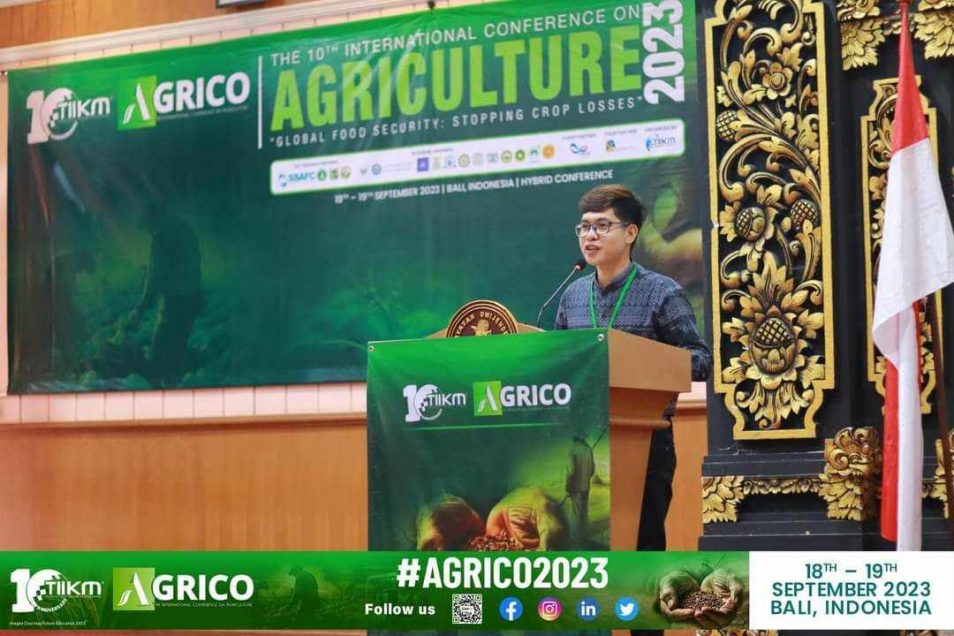
SU Agriculture faculty, student present research on farmer-bred corn for silage, natural pesticide for rice at int’l confab

(L-R) Silliman University (SU) College of Agriculture fourth-year student John Kenneth B. Escalania and faculty member Rehel A. Diaz at the 10th International Conference on Agriculture (AGRICO) on September 18-19, 2023 in Bali, Indonesia.
Silliman University (SU) College of Agriculture faculty member Rehel A. Diaz and fourth-year student John Kenneth B. Escalania presented their research papers on farmer-bred maize or corn for silage and internal organs of fish as a natural pesticide for rice, respectively, at the 10th International Conference on Agriculture (AGRICO) on September 18-19, 2023.
Held in Bali, Indonesia, the conference focused on the theme, “Global Food Security: Stopping Crop Losses.”
The AGRICO gathers academicians, university students, international industry experts, researchers, scientists, policymakers, and other professionals to share their knowledge and experiences in the field of Agriculture.
Farmer-bred maize for silage production
Diaz presented a research paper he co-authored with Fred C. Delfino, John Bethoven S. Alaba, and Louella M. Badon, titled “Assessing the Silage Potentiality of Farmer-Bred Maize (Zea Mays L.) Varieties Using Agronomic and Chemical Markers.”
Silage is a type of feed for livestock that is made by cutting a crop, such as grass or corn, when it is green and then storing it in tower silos, pits, or trenches to ferment.
The paper was a study on farmer-bred maize varieties and their potential for silage production, suggesting that they are a sustainable choice even if there are already varieties that have been cultivated specifically for silage production.
“Amid environmental pressures, utilization of farmer-bred maize variety is sustainable as it requires lesser agrochemical inputs while producing excellent silage yield and quality,” wrote the authors in the paper’s abstract.
The study is the first of its kind in the Philippines because, according to the abstract, “no study was conducted to understand the potential of farmer-bred maize varieties for silage production.”
The study assessed the silage potential of five farmer-bred varieties collected from the provinces of Masbate and Negros Oriental by comparing them to a quality maize protein open-pollinated variety (OPV) as a standard, using agronomic and chemical markers.
“The agronomic markers used were leaf angle, leaf area index, crop growth rate (CGR), and silage yield while crude protein and acid detergent fiber (ADF) were the chemical markers,” wrote the authors.
Results revealed that the leaf angle, leaf area index, and CGR of the five farmer-bred varieties are “comparable to that of existing quality protein OPV.”
Meanwhile, in terms of silage yield, two farmer-bred varieties from Dauin and Ayungon “outperformed” the quality protein OPV.
In terms of chemical markers, the study found that the crude protein content of farmer-bred varieties from Dauin and Ayungon is “comparable” to that of the quality protein OPV.
The farmer-bred variety from Dauin was found to be the “most digestible” for having the lowest ADF content and has the “highest silage potentiality” among the farmer-bred varieties tested due to its high silage yield, crude protein, and low ADF.
On the other hand, the authors wrote that the farmer-bred variety from Ayungon has “a good potential” for silage production due to its high silage yield and crude protein, but it is “less digestible” because of its high ADF.
Natural pesticide for rice from fish
Escalania presented a research paper he co-authored with Diaz, Jose Gabriele Monterola, Georich Novesteras, Rouselle Santos, and Jay Cresca Silorio, titled “Assessing the Effectiveness of Fish Viscera as an Attractant to Insect Pests of Rice (Oryza Sativa L.) at Grain-Filling Stage.”
The study found that the viscera or internal organs of fish can attract rice bugs, which the authors described as the most dangerous insect pests of rice during the grain-filling growth stage.
The authors wrote that fish viscera can attract rice bugs because of its “strong fish odor caused by trimethylamine.”
In the study, fish viscera also attracted “beneficial arthropods” such as spiders, which are “natural enemies” of insect pests in an agro-ecosystem.
The authors also described fish viscera as “environmentally sound” compared to synthetic insecticides.
“Rice, as the leading staple crop in the Philippines, has been under the constant threat of insect pests. Over-reliance on synthetic insecticides in controlling insect pests has been proven to have a detrimental impact on the environment and the whole food chain,” wrote the authors in the paper’s abstract.
The fish viscera used in the study was from the Dumaguete City Public Market.
The researchers conducted the experiment at the rice field of the SU College of Agriculture farm, wherein they tied up fish viscera at the tip of one-meter bamboo sticks that were scattered within 2,000 square meters of the rice field. They made observations twice a day for two weeks.
“The use of fish viscera in tandem with other environmentally sound tactics in managing insect pests posits sustainability in rice production minimizing losses caused by pests,” wrote the authors.

Escalania presents a research paper he co-authored, titled “Assessing the Effectiveness of Fish Viscera as an Attractant to Insect Pests of Rice (Oryza Sativa L.) at Grain-Filling Stage.”

Diaz presents a research paper he co-authored, titled “Assessing the Silage Potentiality of Farmer-Bred Maize (Zea Mays L.) Varieties Using Agronomic and Chemical Markers.”



